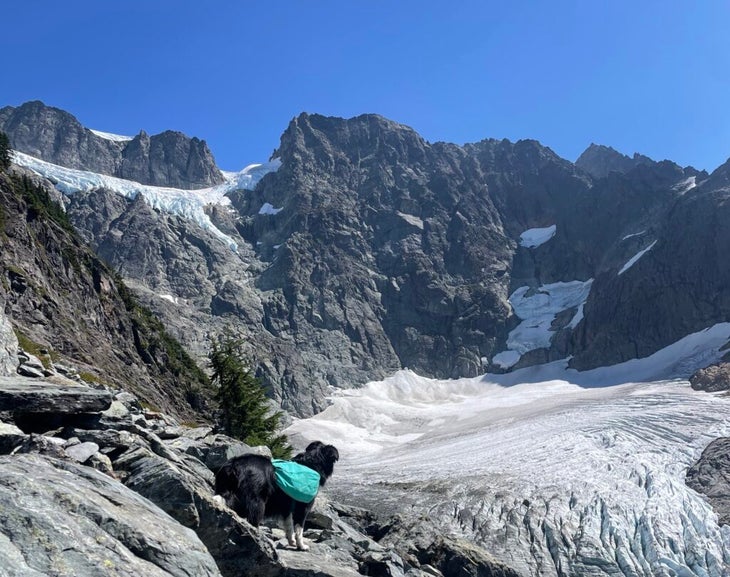Heading out the door? Read this article on the new Outside+ app available now on iOS devices for members! Download the app.
My dog’s first backpacking trip was a momentous occasion—I’d taken her on increasingly difficult hikes throughout her puppyhood, dreaming about all of the extended adventures we could take once she was fully grown and trail fit. Her endurance quickly surpassed mine; on off-leash trails, she’d wait for me from one switchback above, peering down at me: Come on, mom! We’ve got miles to cover.
Once she was fully-grown and an experienced trail dog, I knew it was time for Juno to start carrying some weight. A dog backpack would allow me to transfer some kibble, treats, and water from my own pack. She clearly had extra energy to burn, anyway. And best of all, I could stash stinky poop bags in her pack instead of mine. She didn’t seem to mind the saddlebags when we took them, empty, for a test ride. Juno zoomed up and down the trail, bounding over logs and rolling in snow patches like usual.
Introducing your dog to a hiking pack takes some consideration to ensure a safe and smooth experience. I sought advice from Dr. Madeline Fellin, a small animal veterinarian based in Butte, Montana. Fellin is the veterinary ambassador for Orvis, and adventures often with her three pups, Bodee, Hopkin, and Lucy.
How much weight can a dog carry?
A dog’s size will determine how much they can carry in a backpack.
“A general rule of thumb is no more than 10 to 12 percent of your dog’s bodyweight,” Fellin says.
You should also consider your dog’s breed, strength, and general health. “Larger, stronger breeds, such as Labrador retrievers, can potentially carry more weight, but consult with your veterinarian first,” said Fellin. She also recommends speaking with your vet if your dog has a long back, like a corgi or dachshund, is under one year old, or has arthritis, orthopedic problems, or heart conditions.
“Test the empty pack around your house first to let your dog get comfortable and used to it, then gradually add small amounts of weight,” says Fellin.

Choosing a Dog Backpack
Fellin says that a breathable pack material like mesh is preferable. Look for a pack with padding on the shoulders and chest straps to ensure maximum comfort for your pup. I also like to use a backpack with a leash attachment that can double as a regular harness.
Consult the manufacturer’s sizing guidelines to make sure you achieve a proper fit. Before hitting the trail, fit the pack to your dog’s body so that it is secure but not restrictive.
Properly Packing Your Dog’s Pack
Just as you’d consider balance when loading your own overnight pack, consider weight distribution on your dog’s back. Saddlebags should have even weight on each side; Juno carries two water bottles, and I always make sure I pour her some water from either side when we stop for a rest.
“Make sure anything in the bag is not poking the sides of your dog and rubbing,” says Fellin. Likewise, check that the straps and buckles don’t rub.
Especially as your dog adjusts to hiking with a pack for the first time, it’s important to watch out for signs of discomfort. “Missing or barbed hair under the pack indicates it is rubbing,” says Fellin.
Keep an eye out for other signs of pain and fatigue like an abnormal gait or limping, frequent stopping, vocalizing, and biting at the pack, which Fellin says can be signs that the pack is too heavy or something else is wrong. In the case of any signs of distress, reduce the weight on your dog’s back, adjust the pack fit, or remove the pack entirely.
Dogs make amazing hiking buddies. Read more here about safely hitting the trail with your canine companion.
